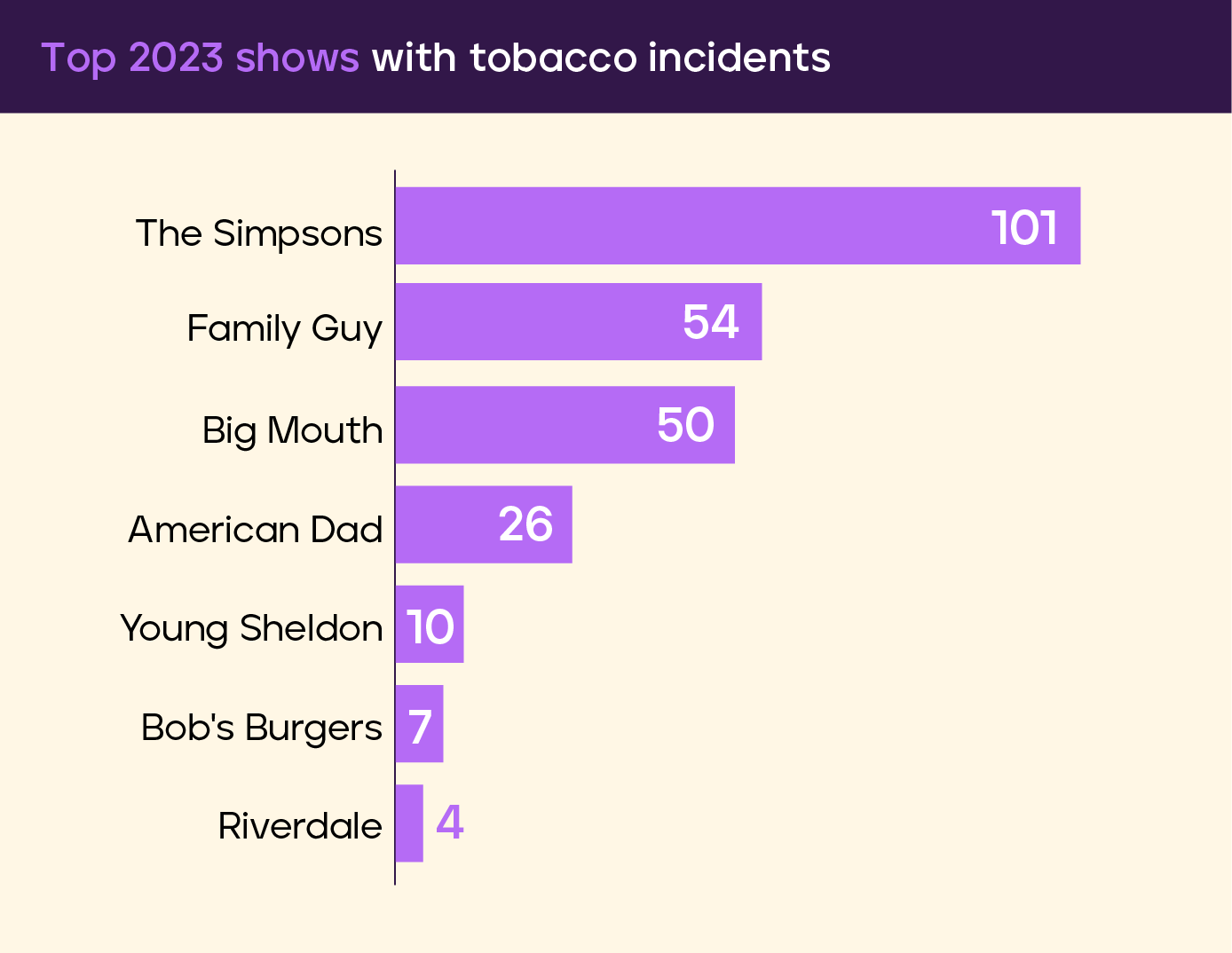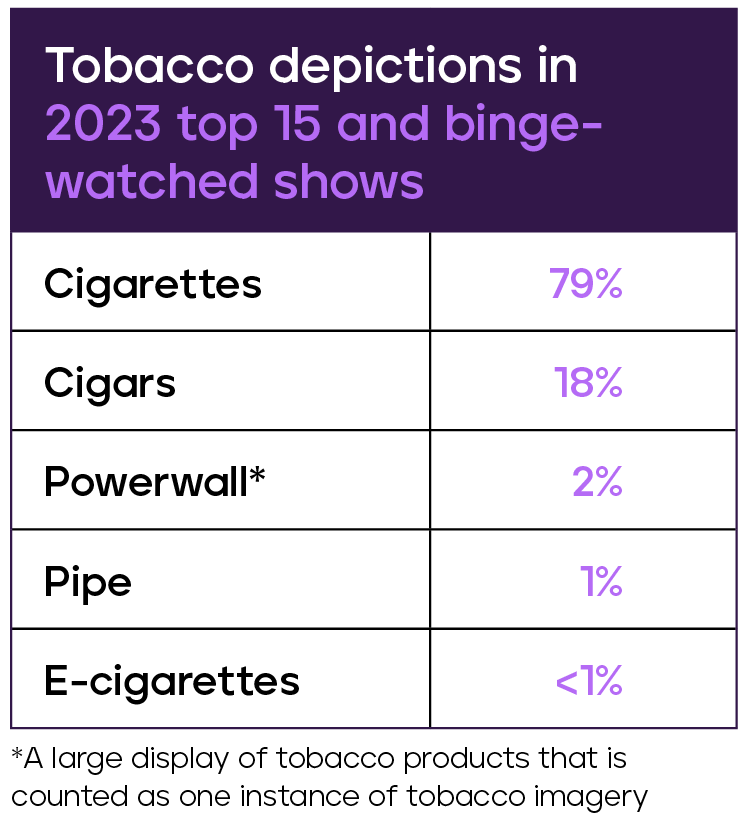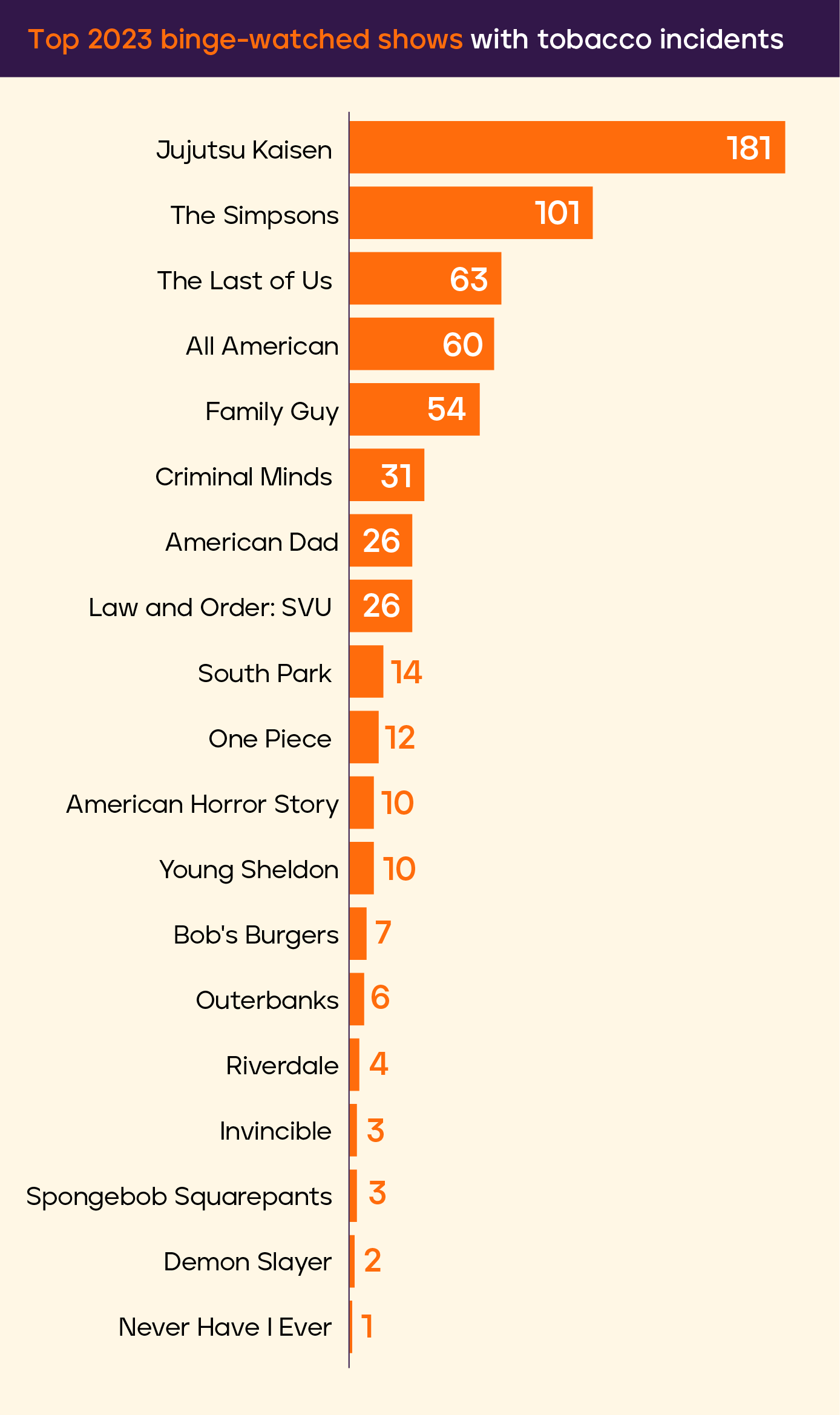LIGHTS, CAMERA, ADDICTION
How persistent on-screen tobacco imagery continues to fuel nicotine addiction among young audiences
Truth Initiative’s seventh annual analysis of tobacco imagery in popular entertainment reveals a troubling picture as smoking continues to permeate top shows, movies, and music videos — despite research that it makes young people more likely to vape nicotine.
On-screen smoking, which is often glamorized and portrayed as edgy and cool, remains stubbornly common across entertainment media as evidence grows of its harmful impact on young viewers. Research on the harms of on-screen tobacco imagery dates back to 2012, when the U.S. Surgeon General concluded that young people are more likely to smoke when they see more tobacco imagery in movies. More recently, a Truth Initiative study published in Preventive Medicine found that exposure to on-screen smoking imagery can triple a young person’s odds of starting to vape nicotine, and multiple studies have established a dose-response relationship, where the more often someone is exposed to tobacco use, the more likely they are to start using tobacco. Upcoming Truth Initiative research also shows that young people who were exposed to more tobacco imagery while binge watching reported higher intentions to vape and smoke in the future.

Youth tobacco use remains a problem in the U.S., with 1.63 million middle and high school students reporting use and, of those, more than 1 in 4 of reporting daily use. The consequences of use are real: nicotine can harm the developing adolescent brain and make young people more susceptible to addiction later in life. Nicotine addiction can increase stress and intensify symptoms of depression and anxiety. These risks are of particular concern in the context of the youth mental health crisis: the results of the Centers for Disease Control and Prevention’s latest Youth Risk Behavior Survey show that despite small, recent improvements, high schoolers’ mental health has worsened over the past decade.
Alongside research collaborators at Breathe California and NORC at the University of Chicago, Truth Initiative examined tobacco imagery in entertainment popular with young people. Among the findings:
- Most popular shows: Seven of the top 15 shows most popular among 15- to 24-year-olds in 2023 displayed tobacco, and of those, all but one has appeared in previous reports, underscoring the persistence of the problem. Though the number of tobacco depictions in these shows decreased by 72% (from 890 in 2022 to 252 in 2023), some popular shows that have typically featured heavy tobacco content, such as “Stranger Things” and “Euphoria,” did not air seasons in 2023.
- Top binge-watched shows: The proportion of top binge-watched shows (defined as watching multiple episodes of a show in one sitting) that displayed tobacco imagery increased from 64% in 2022 to 70% in 2023.
- Movies: In 2023, the number of movies depicting tobacco increased for the first time since 2020. Of top films released in 2023, 41% contained tobacco, compared to 35% in 2022. Tobacco incidents in movies also increased—by 70% compared to movies released in 2022. Additionally, eight out of 10 of 2025’s “Best Picture” nominees featured tobacco, and several starred celebrities normalizing smoking on screen, including Timothée Chalamet and Selena Gomez.
- Music videos: In 2023, almost 1 in 4 (23%) of chart-topping songs with music videos featured tobacco in their videos, down from 28% in 2022. The videos were viewed almost 5 billion times on YouTube as of October 2024.
Decisionmakers at all levels, including entertainment executives and leaders of streaming platforms and broadcast networks, showrunners, directors, writers, actors, and music artists, have a role to play to help protect young people from a lifetime of addiction.

On-screen smoking, which is often glamorized and portrayed as edgy and cool, remains stubbornly common across entertainment media as evidence grows of its harmful impact on young viewers.
Introduction
Truth Initiative’s seventh annual analysis of tobacco imagery in popular entertainment reveals a troubling picture as smoking continues to permeate top shows, movies, and music videos — despite research that it makes young people more likely to vape nicotine. Alongside research collaborators at Breathe California and NORC at the University of Chicago, Truth Initiative examined tobacco imagery in entertainment popular with young people and found rampant on-screen smoking. Seven of the top 15 shows most popular among 15- to 24-year-olds in 2023 displayed tobacco, and of those, all but one has appeared in the previous six reports, underscoring the persistence of the problem. The picture looks even worse for movies: the number of movies released in 2023 depicting tobacco increased for the first time since 2020. And while the number of chart-topping songs featuring tobacco in their music videos decreased from 28% in 2022, almost 1 in 4 still included tobacco.
On-screen smoking, which is often glamorized and portrayed as edgy and cool, remains stubbornly common across entertainment media even as a body of peer-reviewed research has established it influences youth tobacco use. The impact of on-screen tobacco use has been well known since 2012, when the U.S. Surgeon General concluded that young people are more likely to smoke when they see more tobacco imagery in movies. More recently, a Truth Initiative study published in Preventive Medicine found that exposure to on-screen smoking imagery can triple a young person’s odds of starting to vape nicotine, and multiple studies have established a dose-response relationship where the more often someone is exposed to tobacco use, the more likely they are to start using tobacco.
Meanwhile, youth tobacco use remains a problem in the U.S., with 1.63 million middle and high school students reporting e-cigarette use and, of those, more than 1 in 4 reporting daily use. The consequences are real: nicotine can harm the developing adolescent brain, increase stress, and intensify symptoms of depression and anxiety, and it may make young people more susceptible to addiction later in life. These risks are of particular concern in the context of the youth mental health crisis: the results of the Centers for Disease Control and Prevention’s latest Youth Risk Behavior Survey show that despite small, recent improvements, high schoolers’ mental health has worsened over the past decade.
Action is needed to protect young people from exposure to tobacco imagery on screens. Studios can develop policies to restrict tobacco imagery in youth-appealing entertainment and urge actors to refuse to use tobacco on screen with “tobacco riders.” Decisionmakers at all levels, including entertainment executives and leaders of streaming platforms and broadcast networks, showrunners, directors, writers, actors, and music artists, have roles to play to protect young people from a lifetime of addiction.

Nicotine can harm the developing adolescent brain, increase stress, and intensify symptoms of depression and anxiety, and it may make young people more susceptible to addiction later in life.
SEASON AFTER SEASON: THE PERSISTENT PROBLEM WITH SMOKING
Seven of the top 15 shows most popular among 15- to 24-year-olds in 2023 displayed tobacco, and of those, all but one has appeared in previous reports. Though the number of tobacco depictions in these shows decreased by 72% (from 890 in 2022 to 252 in 2023), some popular shows that have typically featured heavy tobacco content, such as “Stranger Things,” “Euphoria,” and the anthology series “Dahmer – Monster: the Jeffrey Dahmer Story,” did not air seasons in 2023. New seasons of these shows either aired in 2024 or are in the works.
The 7 shows among the top 15 to contain tobacco were “American Dad,” “Big Mouth,” “Bob’s Burgers,” “Family Guy,” “Riverdale,” “The Simpsons,” and “Young Sheldon.” (See “Methods for Show Selection and Analysis” in the appendix for a full list of shows.) In total nearly 17 million young people were exposed to streaming shows that feature tobacco in 2023.i
While two repeat offenders decreased their tobacco depictions (“Bob’s Burgers” moved from 8 depictions to 7, and “The Simpsons” decreased its depictions from 195 to 101), every top show that included tobacco in 2022 also included it in 2023. Several shows increased their tobacco imagery from 2022 to 2023, including “American Dad,” “Big Mouth,” “Family Guy,” and “Riverdale.”
This year, 5 out of 6 animated shows in the top 15 contained tobacco imagery. All are repeat offenders. According to Ypulse’s 2022 Media Consumption Report, animated shows are more popular with Gen Z than with any other demographic. “The Simpsons” contained the most tobacco depictions among the top 15 shows.
A TOP SPOT FOR “THE SIMPSONS”
“The Simpsons,” which aired its 35th season in 2023, pops up frequently in this report series, often claiming the number two or three spot among the top 15. The show’s tobacco content has varied widely: in 2021, the show contained 75 incidents, while in 2022, it contained 195. In 2023, it was the top offender, although it decreased its tobacco imagery to 101 depictions. “The Simpsons” also appears among the most binge-watched shows, meaning that past seasons continue to expose young people to tobacco imagery.
Despite being a pioneer of the “adult animation” genre, “The Simpsons” is rated TV-14 and has remained popular among young people over its decades-long run. Research from Parrot Analytics shows the Simpsons is the fourth-most popular show in the US, and one fifth (19.8%) of that audience is between 13–22 years old.
“The Simpsons” streams on Disney+, which has the second-largest Gen Z audience by percentage of viewers after Netflix. While Disney has strict policies against tobacco imagery in its original programming, its streaming platform can expose new generations of young people to tobacco imagery.

TOBACCO IMAGERY AMONG BINGEWATCHED SHOWS
People aged 18 to 39 are more likely to binge-watch, or consume multiple episodes of a show in one sitting, than older people. According to a survey by the American Academy of Sleep Medicine, 88% of U.S. adults report losing sleep as a result of binge-watching. Frequent binge-watching can increase feelings of isolation and loneliness; given nicotine’s potential to increase stress and intensify symptoms of depression and anxiety, any potential link between these behaviors merits observation.
Truth Initiative researchers asked young people which shows that aired new seasons in 2023 they had binge-watched and then coded the 2023 season for tobacco imagery. Researchers also asked young people which previously coded tobacco offenders they had binge-watched to measure whether young people are continuously watching older shows with tobacco.
The number of binge-watched streaming shows containing tobacco imagery increased from 64% in 2022 to 70% in 2023. Binge-watched shows that increased their tobacco content include “American Dad,” “Law & Order SVU,” “Never Have I Ever,” “South Park,” and “SpongeBob SquarePants.” Newcomers to the list of most binge-watched shows that depict tobacco include “Demon Slayer,” “Invincible,” “Jujutsu Kaisen,” “One Piece,” “Outer Banks,” “The Last of Us,” and “Young Sheldon.”
Overall, the number of tobacco depictions decreased significantly among binge-watched shows from 2,002 to 614. The top offender in 2023, “Jujutsu Kaisen,” contained 181 depictions (more than a quarter of total tobacco depictions across shows), a significant decrease from 2022’s top offender, “Peaky Blinders,” which contained 893 depictions. “All American” and “The Simpsons” both decreased their tobacco imagery, from 66 to 60 and 195 to 101, respectively.
Even shows aimed at young children contain tobacco. Once again, “SpongeBob SquarePants” continues to depict tobacco imagery. The show’s Y-7 rating means tobacco’s influence could be reaching children as young as first grade. The animated show portrayed pipes three times in 2023, compared to once in 2022. It has also been ranked multiple times among the most binge-watched, indicating its popularity among young people.
Shows flagged in previous years as tobacco offenders are available through streaming services and continue to be popular with young people. In 2023, more than half of young people reported watching popular previous tobacco offenders such as “Stranger Things,” “The Walking Dead,” and “Shameless.” Through these services, young people have access to a vast library of entertainment, including older content. Such content is more likely to portray tobacco, do so more frequently, and portray smoking as a normal, harmless behavior.
Moreover, new research found a dose-response relationship between binge-watched content with tobacco depictions and potential tobacco use. According to internal analyses conducted by Truth Initiative, young people who were exposed to more tobacco imagery while binge-watching shows reported higher intentions to use tobacco in the future.

ANIME ASCENDS IN POPULARITY
Two of this year’s most binge-watched shows containing tobacco are anime adaptations of manga, or Japanese comics or graphic novels (“Jujutsu Kaisen,” with 181 depictions, and “Demon Slayer,” with 2). “Jujutsu Kaisen,” which contained the most tobacco depictions of any binge-watched show this year, is a fantasy action series with a school-aged protagonist. The Parrot Analytics report finds that Jujutsu Kaisen is immensely popular (41.21× as popular as the average show), and that Gen Z comprises 68.8% of its viewership.
“One Piece,” a TV-14-rated show with 12 depictions, is a live-action adaptation of a manga series that had previously been made into an anime series. The PG-rated anime movie “Suzume” contained 15 tobacco depictions.
In 2022, the series “Attack on Titan” contained 11 total tobacco depictions. (“Attack on Titan” aired part of its fourth season in 2023 but did not rank among the top 15 or most binge-watched shows for the year.) Not all anime features tobacco. Season 2 of “Demon Slayer,” which ranked among the top 15 in 2022, did not depict tobacco.
In the U.S., viewers can stream these programs on Netflix, Hulu, and Crunchyroll, a subscription streaming service specializing in East Asian media. TheWrap reports that some animated shows are so anticipated that they’ve brought back appointment viewing among Crunchyroll’s largely Gen Z audience, according to Gita Rebbapragada, the streamer’s chief operating officer.
A COMPLEX WEB
Tackling tobacco in entertainment requires the involvement of many parties. Individual networks harm public health when they feature tobacco in their original programming. The streaming services that make that content available on-demand also bear responsibility. Companies often license their programs to streaming platforms — sometimes multiple platforms at once — for a specific period. To be released in another country, a show or film must first be licensed in that country.
Further complicating the picture, companies sometimes merge with or acquire other companies. For example, Disney bought 21st Century Fox in 2019. Discovery and WarnerMedia merged in 2022 to create Warner Bros. Discovery, which includes networks CNN and HBO and streaming services Max and Discovery+.
These factors create a complex landscape where it is difficult to hold a single company accountable for the tobacco content in its programming. For this reason, Truth Initiative advocates for a more comprehensive approach, where responsibility is shared among networks, creators, studios, and the streamers that deliver their content to viewers.
MOVIE PROGRESS GOES UP IN SMOKE
We have known since the U.S. Surgeon General’s 2012 report, “Preventing Tobacco Use Among Youth and Young Adults,” that exposure to tobacco imagery in movies makes young people more likely to start smoking. This relationship is dose-dependent, meaning that the more young people see smoking in movies, the higher their risk of initiating tobacco use.
Tobacco depictions in movies increased by 70% in 2023, according to the report “Tobacco in Films: 2023” from NORC at the University of Chicago, which analyzed tobacco depictions in top 2023 movies. A 6 percentage-point increase in the proportion of films to portray tobacco marks the first time this figure has increased in three years. In 2023, films averaged 14 tobacco incidents per film, compared to about 10 per film in 2022.
These 141 movies contained a total of 1,989 tobacco incidents: 83 in G/PG-rated films, 535 in PG-13 films, and 1,371 in R-rated films. Compared to last year, incidents in G/PG-rated films declined, while incidents in PG-13-rated films increased and tobacco incidents in R-rated films nearly doubled.
Film viewership increased in 2023, compounding the harm of more movies portraying more tobacco. All told, films shown in theaters exposed about 283 million youths and adults to tobacco imagery, while movies on streaming platforms exposed approximately 29.8 million young people aged 15–24.
Studios must keep tobacco out of youth-rated films and, at minimum, package rereleased films with an appropriate disclaimer. Motion Picture Association (MPA) studios release fewer PG-13-rated movies with tobacco (3) than non-MPA studios (10), but because of its re-releases, MPA studios released more PG-rated films with tobacco (3) than non-MPA studios (1).
The top 15 movies containing tobacco that were rated PG-13/TV-14 or under were:
1. About My Father, PG-13
2. Asteroid City, PG-13
3. Avatar, PG-13
4. Hocus Pocus, G/PG
5. Indiana Jones and the Dial of Destiny, PG-13
6. Jesus Revolution, PG-13
7. Paint, PG-13
8. Past Lives, PG-13
9. Sound of Freedom, PG-13
10. Star Wars: Episode VI-Return of the Jedi, G/PG
11. Suzume, G/PG
12. The Boy and the Heron, PG-13
13. The Boys in the Boat, PG-13
14. The Color Purple, PG-13
15. The Hill, G/PG 16. Titanic (25th Anniversary), PG-13

LEGACY FILMS
NORC identified “legacy films” — older films re-released in theaters and films that depict prominent historical figures using tobacco — as an important avenue for tobacco imagery exposure. Legacy films account for nearly a quarter (23.7%) of tobacco incidents in movies this year. Tobacco content in these re-released films, and films that depict historical tobacco use, may normalize tobacco use for modern viewers.
All legacy films released or re-released this year showed tobacco. And these films are not only more likely to contain tobacco — they also show tobacco more frequently than contemporary films. Legacy films contain about 54 incidents per PG-13-rated film, compared to about 6 incidents per contemporary PG-13-rated film. Given that the relationship between exposure to tobacco imagery and smoking initiation is dose-dependent, these films put youth at a higher risk of initiating tobacco use.
This should not be a case where history repeats itself. Truth Initiative research shows that while cigarettes and cigars are the most popular tobacco products onscreen, they encourage the use of e-cigarettes, which are much more popular among young people.
ALMOST 1 IN 4 MUSIC VIDEOS FEATURE TOBACCO
Tobacco imagery in popular music videos decreased in 2023. Analysis of the top 2023 Billboard songs revealed that 23% of songs with music videos contained 212 depictions and were viewed nearly 5 billion times. This figure is fewer than half of the 462 depictions that appeared in 28% of music videos in 2022.
The top five music videos containing tobacco imagery are “Elovgra” by Alex Favela, Grupo Marca Registrada, and Joaquin Medina (23 depictions), “What It Is (Block Boy)” by Doechii featuring Kodak Black (18), “Shirt” by SZA (14), “I Know” by Travis Scott (10), and “Nonsense” by Sabrina Carpenter (10).
Hot R&B/Hip-Hop is the genre with the most depictions for the third year in a row: tobacco appeared 103 times in 38% of Hot R&B/HipHop music videos. Dance/Electronic came in second, with 28% of music videos featuring 65 tobacco depictions.
In 2023, a few songs by artists such as Taylor Swift, Morgan Wallen, and SZA topped the charts for weeks, resulting in a smaller pool of music videos. And many of 2023’s top songs did not have music videos: 167 of the top Billboard songs had music videos, compared to 212 in last year’s report and 243 the year before. Video viewership also declined by about 29%.

CALL TO ACTION
Years of research have established a strong link between exposure to tobacco imagery and tobacco use, and yet tobacco persists on screens. After years of progress, producers, directors, and writers continue to prioritize creative expression over public health, exposing an estimated 283 million people via movies in theaters, 29.8 million youth via streaming movies, and 17 million youth through shows on streaming platforms this year alone.
Truth Initiative applauds the studios and networks that have decreased and even eliminated tobacco content from their programming. For example, Fox’s “Rick & Morty,” which featured 25 tobacco incidents in 2020, has been free from tobacco for two seasons in a row. The fact that 53% of the top 15 shows most popular with people aged 15 to 24 are free from tobacco demonstrates that shows do not need tobacco content to win favor with young people.
Yet the entertainment industry as a whole must do more to meet this public health need. Despite a 2019 pledge that all new shows rated TV-14 and below would only allow depictions of tobacco “for reasons of historical or factual accuracy,” Netflix is still churning out youth-rated original programming that portrays tobacco. This includes 2023’s “One Piece,” a live action adaptation of a popular manga series, unburdened by considerations of historical or factual accuracy. And Netflix isn’t the only streamer that isn’t living up to its own standards. Despite strict policies against tobacco content in Disney’s original content, Disney+ offers young people a gateway to tobacco content by distributing “The Simpsons,” this year’s top offender among the top 15 shows most popular with young people.
Truth Initiative calls for a comprehensive set of actions and policies to mitigate the harm of depicting tobacco onscreen, such as:
- Developing and publicizing anti-smoking policies – Studios should develop policies that restrict tobacco in youth-rated content similar to those in effect among members of the Motion Picture Association. Non-MPA member studios continue to be the top offenders regarding tobacco depictions, releasing 74% of the films that portrayed tobacco in 2023. Studios should hold themselves accountable by making these policies public.
- Increasing awareness and outreach – Increased awareness about the harms of on-screen tobacco is needed. Public health organizations should educate parents and young people, as well as public officials and creative stakeholders such as directors, writers, producers, and actors, about how on-screen tobacco risks leading young people to a lifetime of nicotine addiction. People with wide-reaching platforms, such as actors, musicians, and influencers, can help spread this message.
- Collaborating with creators – Understanding how showrunners and creators operate can be helpful in educating and persuading them to remove tobacco content. Truth Initiative is partnering with Hollywood Health and Society to conduct qualitative interviews to understand the issue from their perspective.
- Empowering actors not to portray tobacco – Actors who understand the harmful effects of on-screen tobacco use could include “no tobacco” clauses in their contracts. If a scene involves tobacco use, SAG-AFTRA could require a “tobacco rider,” similar to the nudity riders used in actors’ contracts today, that outlines the parameters of tobacco use and includes appropriate warnings about the health impacts of prop cigarettes and the impact of tobacco imagery on young audiences. In the same vein, show runners and content developers should be encouraged to understand the connection between tobacco imagery and youth tobacco use and choose not to prioritize such imagery over the health of young people.
- Monitoring compliance with existing regulations – A ban on paid tobacco product placements in movies and shows was codified into federal law in 2009, but shows and movies continue to provide free advertising for the tobacco industry today. The film industry must certify that tobacco companies did not exchange anything of value for depictions of smoking or vaping in a show or movie. Furthermore, studios must cooperate with restrictions that prevent films that contain tobacco from qualifying for local tax breaks and other incentives.

Years of research have established a strong link between exposure to tobacco imagery and tobacco use, and yet tobacco persists on screens. Truth Initiative calls for a comprehensive set of actions and policies to mitigate the harm.
More in tobacco in pop culture
Want support quitting? Join EX Program
By clicking JOIN, you agree to the Terms, Text Message Terms and Privacy Policy.
Msg&Data rates may apply; msgs are automated.






